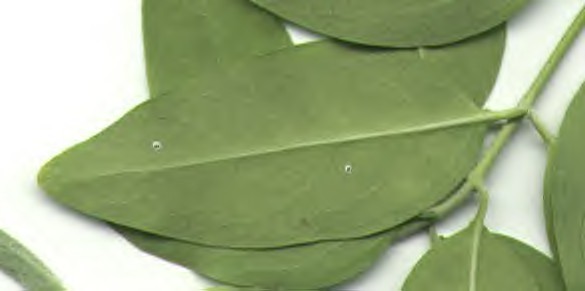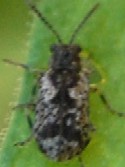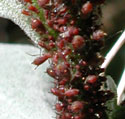February
Feb 2 (1998): The Mediterranean Gecko showed itself for the first time after the winter (Did it know about Ground Hog Day?). The Jojoba Bush is in bloom, but you would hardly notice because the flowers are green and without petals. Lots of Pellitory (a stingless member of the Nettle Family) (Parietaria hespera) seedlings have come up. When they begin blooming in a couple of weeks they will go mostly unnoticed because the minute flowers are also green.
Feb 12 (1998): It was 3:00 am when the echoing songs of a practicing Northern Mockingbird (Mimus polyglottos) began filtering in through my open bedroom window. In fact a lot of the birds that visit my yard and the townhouse commons areas have been singing more frequently and with more gusto. A reminder that spring is in the air! The House Finches sing a complicated musical allegro, the Inca Doves a plaintive two-note call, and the House Sparrows an excited noisy chatter.
Mr. Mockingbird kept it up for a good 30 minutes concatenating a medley of 3 to 8 second segments, some seemingly original, some clearly copied from other kinds of birds in the area. Listening more carefully, I could discern distinct segments lifted from the repertoires of a Northern Cardinal, the Curve-billed Thrasher, the House Finch and a Western Kingbird. Each mockingbird comes up with a more or less unique composition, then perfects it, and seemingly tries to run through the medley as quickly and flawlessly as possible. The more complex the better. Some of my human acquaintances complain about these late night chorusers. I like the reminder that there is life that is exciting and beautiful.
Feb. 19 (2000): The Wolfberry shrub (Lycium andersonii) is covered with flowers. But it's difficult to see that because the blooms are so small (tubular flower is 7 mm long and 4 mm wide) and are pale lavender. The buzzing bees and Hover Flies (Syrphidae) caught my attention first. In a month or so there should be a crop of red berries with a flavor like tomatoes. Birds also eat the berries and carry the several seeds in their gut, later discharging them in their feces. This is the wolfberry's plan for dispersal!
The leaves of the wolfberry are fleshy and when new are covered with gland tipped hairs. The glands exude a sticky glue that will immobilize small insects. A kind of leaf beetle (Chrysomelidae Monoxia) mines between the leaf surfaces as a larva and chews the leaves as an adult. These beetles and other insects are also sought as food by birds and spiders.
On the undersides of leaves, especially those of the Mascagnia vine, I find tiny white hibernacula. These are resting whiteflies. Soon they will emerge as winged females that will alight on plants to begin new colonies:

The white spots with the black centers are hibernacula, overwintering resting stages for whiteflies.
Feb 24 (1998) Hail, and lots of it, came down while I was at work today. Half the leaves were stripped from the Arrow Weed and the Desert Honeysuckle. It took more than 4 hours for all the piles of pea-size ice pellets to melt. Along with the hail came another 20 mm of rain. A slimy patch of green algae has formed where the downspout drips. This desert is now very wet.
Feb 21 (1998): For the first time, I had a Lincoln's Sparrow visit my little yard. Such a delicate and beautiful bird. I hope it returns tomorrow. I put out just a bit of birdseed as encouragement.
Feb 12 (1998):
Saga of a BROWN AMBROSIA APHID (Macrosiphum
ambrosias) Colony
Two days ago, a single, winged, female aphid settled down onto a tender new leaf of my Canyon Ragweed. She's plump, 2½ mm long, dark burgundy-black, and has two pair of clear gossamer wings. Already there are today three tiny offspring sitting beside her. They were born live, as most aphids are, and will grow very rapidly to adult size. Unlike their mother, however, they will not develop wings, nor will they have any need to mate. They can reproduce parthenogenically without males. In fact, these newborns already hold the developing embryos of their own offspring. In other words, they were born pregnant. This is how aphid populations can multiply so rapidly. Feb. 13: Now there are five youngsters. Two are noticeably larger, but still much less than 1 mm. Feb. 14: Daughter # 6 was emerging from the posterior of the mother aphid. When the newborn was 90% out, the mother tipped her abdomen towards the leaf surface so that the little one could grasp on, otherwise it would have fallen away from the vertical surface.
Feb. 20: Despite a string of chilly (high 15° low 7° C) rainy days the aphid family continues to grow. Thirteen young now share the same leaf with the founding mother. The largest is 1/3 the size of the mother. Besides thirteen aphids, there are also several pale aphid "ghosts". These are exoskeletons shed by molting aphidlings. The tarsal claws on the feet continue to hold the empty shell to the plant. Feb. 22: A very productive weekend! The 21 offspring are beginning to disperse away from that first tender leaf. The plant's been growing and the leaf maturing to a less tender, more bitter taste. So up the stem they move towards even younger leaves. Even mom has ventured upwards towards the growing tip.
Feb. 24:The morning started out warm and sunny and there were 23 young scattered onto 4 different leaves. The largest of this first generation was 50% of the adult size. In the afternoon a natural disaster, in the form of torrential rain and hail, left only 10 survivors and the founding mother nowhere to be found. Being winged she might have flown off. Or possibly her wings and larger size increased the chances of getting struck by a rain drop or hail stone.
Feb. 28: Of the ten survivors, one aphidling was about 1/2 the adult size. Searching the plant, I at last found the adult female; apparently she had been knocked from the plant during the hail storm and managed to crawl up onto a branch near the ground. There she had already born two new live young. As it turned out, this was a very fortuitous move: Later in the day, a Verdin happened by the original colony site and ate every last aphidling. So now the family is reduced to the mom and two very small young. March 2: With warm temperatures and sunny skies both the canyon ragweed and the aphids were growing very productively. At her new location on the plant the aphid mom's herd of offspring had rebounded to ten. But, fate finally caught up with her, as the male Verdin happened by again and searched the plant high and low 'till he found that plump aphid. The days' old tiny young are now alone to fend for themselves.
March 8: The ten young continue to grow with the largest one a little more than half the size of the founding mother. They've dispersed to several leaves with no two aphids sitting close to one another. Their small size and dispersed group may have helped them avoid predation by the hungry Verdin. A few days ago, I saw the Verdin pulling a thin, but thorny twig, from the Palo Verde with obvious intent on using it in nest construction. As the Verdins bring on their new family, the aphids will face an increasing risk of becoming prey.
March 9: Noticeably smaller than its mother was, the largest of the F1 Generation bore two live young, the first of the F2 Generation. The other nine F1'ers continue to grow. The Verdin hasn't discovered them yet despite several visits per day.
March 19: A few days after the last report, the Verdin apparently did stop by and take all but two of the F1 aphids. However, both of these aphids are now mature and producing many of their own young. This F2 generation now has 28 individuals, several of which are nearly full grown themselves! These patches of aphids are fairly conspicuous, so it seems surprising that even more have not been taken prey by the Verdin. It may well be that the aphids have deposited unpleasant chemicals in their bodies, making them less desirable to eat.
March 24: The F2 generation now numbers 50 aphids and several of those are producing young F3 aphids. I am more convinced now that the Verdins don't find these bugs very palatable.
By late spring, after many wingless, maleless, parthenogenic generations, possibly coinciding with the changing of the seasons, the aphids will again bear both males and females that will also grow wings. They will fly off, mate, and find some place to overwinter (maybe on a completely different plant, depending on the specific kind of aphid.)



